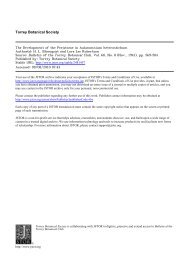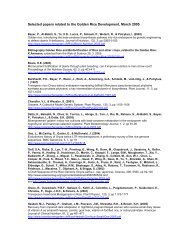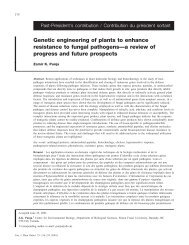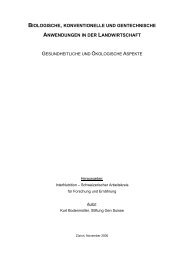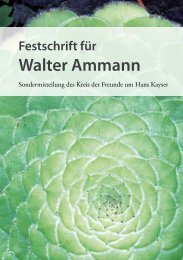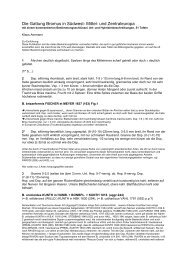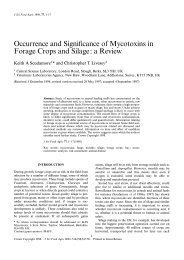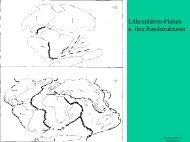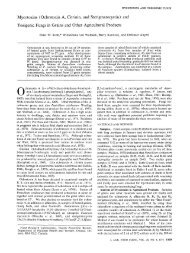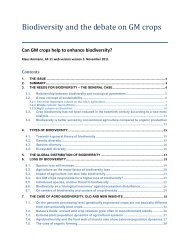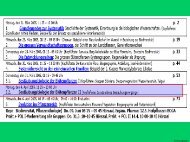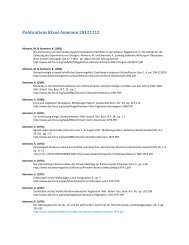Zeitschrift für Gletscherkunde und Glazialgeologie, Bd - entsteht die ...
Zeitschrift für Gletscherkunde und Glazialgeologie, Bd - entsteht die ...
Zeitschrift für Gletscherkunde und Glazialgeologie, Bd - entsteht die ...
Sie wollen auch ein ePaper? Erhöhen Sie die Reichweite Ihrer Titel.
YUMPU macht aus Druck-PDFs automatisch weboptimierte ePaper, die Google liebt.
254 K. Ammann<br />
THE VARIATIONS OF THE OBERAAR GLACIER DURING THE 18TH,<br />
19 TH AND 20TH CENTURY<br />
SUMMARY<br />
In order to study the history of plant communities in the Oberaar Valley (Switzerland, 6 km WSW Grimsel pass) it was<br />
necessary to also consider the glacial variation of the nearby Oberaar Glacier.<br />
Moraines l- 4 were dated and the maximum age of the subsequent forefields l- 3 estimated, using about 30 documents<br />
(photographs, engravings, maps, reliefs, unpublished and published accounts). Glacial variations resulting in moraines<br />
seen today were as follows :<br />
1. Maximum advance in postglacial times: About 1860. Produced moraine ("Wall") W 1, destroyed moraines Wa and<br />
Wb.<br />
2. Advance or stationary phase until about 1890. Formation of moraines W2 and W3 aro<strong>und</strong> 1890.<br />
3. Last advance about 1920, formation of moraine W 4.<br />
For additional information see chapters 3, 4 and 5 and graph fig. 19.<br />
From those moraine dates the following maximum ages of the forefields 1- 3 can be derived :<br />
Forefield 1 (inside moraine W1): About 110 years (98-115 years).<br />
Forefield 2 (inside moraine W2 and 3): 75-90 years.<br />
Forefield 3 (inside moraine W 4) : 50 years and younger.<br />
In the introduction and the appendix (chapter 7) the structure of the research program is given in rough outlines and<br />
some preliminary results are presented: 7.1. Present vegetation of the Oberaar Valley. 7.2. Pollen morphology of the<br />
Grimsel flora. 7.3. Modern surface samples and pollen analyses of two profiles.<br />
LES OSCILLATIONS DU GLACIER DE L'OBERAAR PENDANT LES 18 ÉME,<br />
19 ÉME ET 20 ÉME SIÈCLES<br />
RÉSUMÉ<br />
Pour étu<strong>die</strong>r l'histoire de la végétation alpine de l'Oberaar (6 km 080 a la hauteur du col du Grimsel) il s'est avéré nécessaire<br />
de prendre en considération les oscillations du glacier de l'Oberaar.<br />
La formation des moraines 1-4 et l'8ge maximum des champs préglaciaires furent détermines au moyen d'environs 30<br />
documents différents (photographies, gravures, cartes, reliefs, rapports publies et non publies).<br />
Les variations du glacier formant des moraines visibles aujourd' hui sont les suivantes:<br />
1. Avancée maximum du postglaciaire: Vers 1860 avec formation de la moraine W 1<br />
("Wall 1") et destruction des moraines Wa et Wb.<br />
2. Avancée ou phase stationnaire des années 1890: formation des moraines W2 et W3.<br />
3. Dernière avancée vers 1920: formation de la moraine W 4.<br />
On trouvera des renseignements supplémentaires dans les chapitres 3, 4 et 5 et dans la fig. 19.<br />
D'après les dates des moraines on peut dériver les âges maximum des champs préglaciaires 1-3:<br />
Champ préglaciaire 1 (dans le cirque de la moraine 1) environ 110 ans (98-115 ans).<br />
Champ préglaciaire 2 (dans le cirque des moraines 2 et 3) 75-90 ans.<br />
Champ préglaciaire 3 (dans le cirque de la moraine 4) 50 ans ou moins.<br />
Dans l'introduction et l'appendice (chapitre 7) un aperçu du programme de recherche et quelques résultats préliminaires<br />
sont donnes: 7.1. Végétation récente de la Vallée de l'Oberaar. 7.2. Morphologie des pollens de la flore du Grimsel. 7.3.<br />
Quelques spectres polliniques d'échantillons de surface et analyse pollinique de deux profils.<br />
EINLEITUNG<br />
Das Ziel einer breiter angelegten vegetationsgeschichtlichen Stu<strong>die</strong> im Gletscherhochtal der Oberaar war es, Hinweise<br />
auf <strong>die</strong> Veränderungen der Pflanzengesellschaften früherer Jahrh<strong>und</strong>erte <strong>und</strong> Jahrtausende in der alpinen Stufe zu<br />
erarbeiten Nach den Untersuchungen meines verehrten Lehrers Herrn Prof. Dr. M. Welten (1947, 1958, 1972: 69ff.),<br />
dem ich <strong>für</strong> seine stete Hilfe herzlich danke, durfte erwartet



